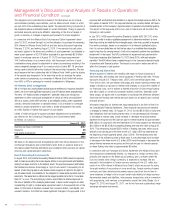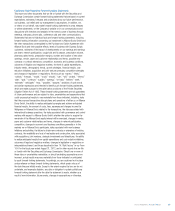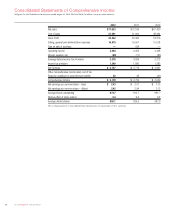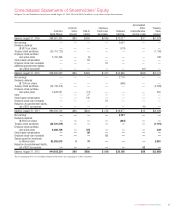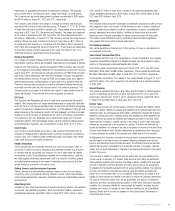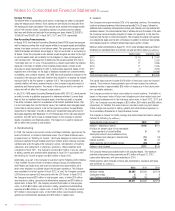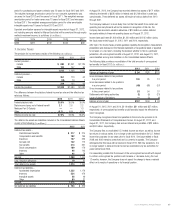Walgreens 2012 Annual Report Download - page 34
Download and view the complete annual report
Please find page 34 of the 2012 Walgreens annual report below. You can navigate through the pages in the report by either clicking on the pages listed below, or by using the keyword search tool below to find specific information within the annual report.
Notes to Consolidated Financial Statements (continued)
32 2012 Walgreens Annual Report
Earnings Per Share
The dilutive effect of outstanding stock options on earnings per share is calculated
using the treasury stock method. Stock options are anti-dilutive and excluded from
the earnings per share calculation if the exercise price exceeds the average market
price of the common shares. Outstanding options to purchase common shares
that were anti-dilutive and excluded from earnings per share totaled 32,593,870,
16,869,061 and 30,661,551 in fiscal 2012, 2011 and 2010, respectively.
New Accounting Pronouncements
In August 2010, the Financial Accounting Standards Board (FASB) issued an exposure
draft on lease accounting that would require entities to recognize assets and liabilities
arising from lease contracts on the balance sheet. The proposed exposure draft
states that lessees and lessors should apply a “right-of-use model” in accounting for
all leases. Under the proposed model, lessees would recognize an asset for the right
to use the leased asset, and a liability for the obligation to make rental payments
over the lease term. The lease term is defined as the longest possible term that is
“more likely than not” to occur. The accounting by a lessor would reflect its retained
exposure to the risks or benefits of the underlying leased asset. A lessor would
recognize an asset representing its right to receive lease payments based on the
expected term of the lease. On the basis of feedback received from comment letters,
roundtables, and outreach sessions, the FASB has made significant changes to the
proposals in the exposure draft and therefore has decided to re-expose the revised
exposure draft in the first quarter of calendar 2013. The proposed standard, as
currently drafted, will have a material impact on the Company’s reported results of
operations and financial position. The impact of this exposure draft is non-cash in
nature and will not affect the Company’s cash position.
In July 2012, FASB issued Accounting Standards Update (ASU) 2012-02, which permits
an entity to make a qualitative assessment to determine whether it is more likely
than not that an indefinite-lived intangible asset, other than goodwill, is impaired.
If an entity concludes, based on an evaluation of all relevant qualitative factors, that
it is not more likely than not that the fair value of an indefinite-lived intangible asset
is less than its carrying amount, it will not be required to perform the quantitative
impairment for that asset. The ASU is effective for impairment tests performed for
fiscal years beginning after September 15, 2012 (fiscal year 2014), with early adoption
permitted. The ASU will not have a material impact on the Company’s reported
results of operations and financial position. The impact is non-cash in nature and
will not affect the Company’s cash position.
2. Restructuring
In 2008, the Company announced a series of strategic initiatives, approved by the
Board of Directors, to enhance shareholder value. One of these initiatives was a
program known as “Rewiring for Growth,” which was designed to reduce cost and
improve productivity through strategic sourcing of indirect spend, reducing corporate
overhead and work throughout the Company’s stores, rationalization of inventory
categories, and realignment of pharmacy operations. These initiatives were
completed in fiscal 2011. The Company recorded $42 million of pre-tax charges
in selling, general and administrative expenses in fiscal 2011 associated with
the Rewiring for Growth program and $66 million in fiscal 2010.
Additionally, as a part of the Company’s Customer Centric Retailing (CCR) initiative,
it has modified the store format to enhance category layouts and adjacencies,
shelf heights and sight lines, and brand and private brand assortments, all of
which were designed to positively impact the shopper experience. This initiative
was completed in the first quarter of fiscal 2012. In total, the Company converted
5,843 stores and opened 559 new stores with the CCR format. In fiscal 2012,
the Company incurred $33 million in total program costs, of which $15 million
was included in selling, general and administrative expenses and $18 million in
capital costs. In fiscal 2011, the Company incurred $144 million in total program
costs, of which $84 million was included in selling, general and administrative
expenses and $60 million in capital costs. In fiscal 2010, the Company incurred
$71 million in total program costs, of which $45 million was included in selling,
general and administrative expenses and $26 million in capital costs.
3. Leases
The Company owns approximately 20% of its operating locations; the remaining
locations are leased premises. Initial terms are typically 20 to 25 years, followed by
additional terms containing renewal options at five-year intervals, and may include rent
escalation clauses. The commencement date of all lease terms is the earlier of the date
the Company becomes legally obligated to make rent payments or the date the
Company has the right to control the property. The Company recognizes rent expense
on a straight-line basis over the term of the lease. In addition to minimum fixed rentals,
some leases provide for contingent rentals based upon a portion of sales.
Minimum rental commitments at August 31, 2012, under all leases having an initial or
remaining non-cancelable term of more than one year are shown below (In millions) :
Capital Lease Operating Lease
2013 $ 16 $ 2,447
2014 12 2,437
2015 11 2,385
2016 11 2,325
2017 9 2,250
Later 158 23,996
Total minimum lease payments $ 217 $ 35,840
The capital lease amount includes $122 million of executory costs and imputed
interest. Total minimum lease payments have not been reduced by minimum
sublease rentals of approximately $29 million on leases due in the future under
non-cancelable subleases.
The Company provides for future costs related to closed locations. The liability is
based on the present value of future rent obligations and other related costs (net
of estimated sublease rent) to the first lease option date. In fiscal 2012, 2011 and
2010, the Company recorded charges of $20 million, $54 million and $90 million,
respectively, for facilities that were closed or relocated under long-term leases.
These charges are reported in selling, general and administrative expenses on
the Consolidated Statements of Comprehensive Income.
The changes in reserve for facility closings and related lease termination charges
include the following (In millions) :
Twelve Months Ended August 31, 2012 2011
Balance – beginning of period $ 145 $ 151
Provision for present value of non-cancelable
lease payments of closed facilities 6 49
Assumptions about future sublease income,
terminations and changes in interest rates (11) (19)
Interest accretion 25 24
Cash payments, net of sublease income (48) (60)
Balance – end of period $ 117 $ 145
The Company remains secondarily liable on 24 assigned leases. The maximum
potential undiscounted future payments are $15 million at August 31, 2012.
Lease option dates vary, with some extending to 2041.
Rental expense, which includes common area maintenance, insurance and taxes,
was as follows (In millions) :
2012 2011 2010
Minimum rentals $ 2,585 $ 2,506 $ 2,218
Contingent rentals 6 9 9
Less: Sublease rental income (20) (15) (9)
$ 2,571 $ 2,500 $ 2,218




